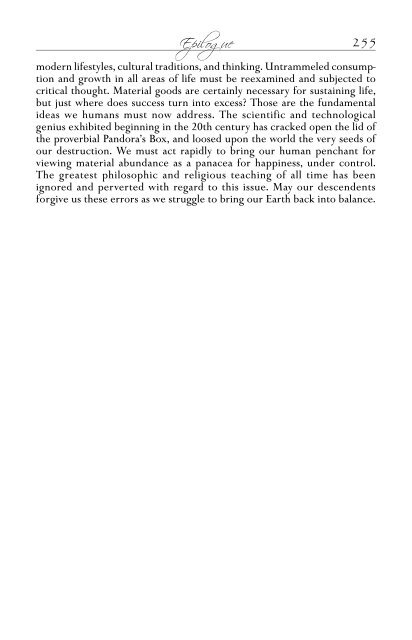edgar-mitchell
edgar-mitchell
edgar-mitchell
You also want an ePaper? Increase the reach of your titles
YUMPU automatically turns print PDFs into web optimized ePapers that Google loves.
128<br />
The Way of the Explorer<br />
to know about something, we must first label what it is we observe, and<br />
then assign qualitative attributes such as size, weight, color, beauty, what<br />
have you, and finally ways to describe how much of the attribute is present.<br />
In science, “how much” is defined by numerical measure. In ordinary language<br />
we use adverbs. We can unequivocally state that mathematics is a<br />
linguistic creation of mind, not an intrinsic characteristic of nature, because<br />
it depends upon how we assign labels to nature, and then quantify<br />
those labels. Waves, particles, apples, and pitchforks are the blue and red<br />
lines on the map, not the roads and highways themselves. And this distinction<br />
is fundamental in resolving questions of mind/matter interaction. The<br />
map is not the territory.<br />
The concept of waves and particles, and their associated measures, is<br />
the best metaphor from the macro-world that we currently have for basic<br />
physical reality, because energy, which is common to both, is not something<br />
we can readily picture. 2 Early in the 20th century scientists understood<br />
even less about how the brain/mind assimilates information than we<br />
do today; that is to say, how it is we know what we know. The Cartesian<br />
conclusion that the role of mind in physical measurement was unimportant,<br />
dominated science until late in the 20th century. But the framers of<br />
quantum theory recognized that the observer’s mind was somehow important<br />
in the observation, and that there were hidden mental traps lurking in<br />
the invisible quantum world. They consistently warned us not to create<br />
and rely upon visual images of the underlying quantum reality, but rather<br />
to place faith only in the measurements derived from experiment. This<br />
became known as the Copenhagen interpretation of quantum physics. As<br />
many scientists of the period were dogmatic materialists, they were skeptical<br />
because quantum theory seemed to enter the forbidden mystical domain<br />
of theology—which indeed it was. They preferred a physics that was<br />
mechanistic. But how else can questions about consciousness be addressed,<br />
and the Cartesian dualism resolved, except by addressing the issue of mind<br />
While the Copenhagen interpretation helped avoid one mental trap, it set<br />
up another involving the meaning of measurements, which still creates<br />
controversy.<br />
The uncertainty principle specifies that complementary variables may<br />
not be measured with equal precision simultaneously. It also defines the<br />
limit of precision (thus the limit of our knowing) in the measurement. The<br />
newcomer to physics often chafes at the idea that there is a limit to the<br />
precision of a measurement. He or she wants to believe that with better<br />
instruments or technique the desired precision can be obtained. But this is<br />
just the natural conclusion of the erroneous belief that waves and particles<br />
represent distinctly different entities, when in fact they do not. Better<br />
instruments will never change that.


